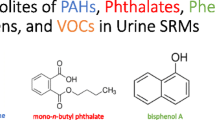Summary
Methods of monitoring occupational exposure to methanol were investigated in volunteer subjects who had ingested small amounts of methanol. It was confirmed that urinary methanol concentrations accurately reflected those in the blood. This relationship was maintained over a considerable range of concentrations in spite of large variations of urine flow. Concomitant ingestion of ethanolic beverages increased the urinary methanol concentration slightly. Urinary formic acid concentration was too variable to be of value but rate of urinary excretion of formic acid did reflect methanol uptake. The ratio of urinary formic acid to creatinine concentrations (F/C ratio) is a practical monitoring method. However, formic acid elimination rate is reduced by ingestion of ethanolic beverages.
Urinary methanol concentration is favoured as a method of monitoring and a concentration of 10 μg/ml measured at the end of the work shift is suggested as the level above which occupational exposure should be suspected and the appropriate action taken.
Similar content being viewed by others
References
Baumann K, Angerer J (1979) Occupational chronic exposure to organic solvents. VI. Formic acid concentration in blood and urine as an indication of methanol exposure. Int Arch Occup Environ Health 42:241–249
Ferry DG, Temple WA, McQueen EG (1979) Toxicity of methanol/petrol mixtures. Alcohol fuels technology. Third International Symposium, Asilomar, California, May 28–31, 1979, vol III
Gonda A, Gault H, Churchill D, Hollomby D (1978) Hemodialysis for methanol intoxication. Am J Med 64:749–758
Kahn A, Blum D (1979) Methyl alcohol poisoning in an 8-month-old boy. An unusual route of intoxication. J Pediatr 94:841–843
Leaf G, Zatman LJ (1952) A study of the conditions under which methanol may exert a toxic hazard in industry. Br J Ind Med 9:19–31
Majchrowicz E, Mendelson JH (1971) Blood methanol concentrations during experimentally induced ethanol intoxication in alcoholics. J Pharmacol Exp Ther 179:293–300
NIOSH (1976) Occupational exposure to methyl alcohol. Criteria for a recommended standard. US Department of Health, Education, and Welfare
Posner HS (1975) Biohazards of methanol in proposed new uses. J Toxicol Environ Health 1:153–171
Smallwood A W (1978) Analysis of formic acid in air samples. Am Ind Hyg Assoc J 39:151–153
Spasovski M, Benchev I (1969) Higeina I zraveopasvane. Exposure test for methyl alcohol. Zraveopasvane 12:333–339
Tada O, Nakaaki K, Fubabori S, Yonemoto J (1975) An experimental study on the cutaneous absorption of methanol in man. J Sci Labour (Jpn) 51:143–153
Wang E (1939) Clinical and experimental investigations on the creatine metabolism. Acta Med Scand [Suppl] 105:1–338
Author information
Authors and Affiliations
Rights and permissions
About this article
Cite this article
Ferry, D.G., Temple, W.A. & McQueen, E.G. Methanol monitoring. Int. Arch Occup Environ Heath 47, 155–163 (1980). https://doi.org/10.1007/BF00716374
Received:
Accepted:
Issue Date:
DOI: https://doi.org/10.1007/BF00716374




